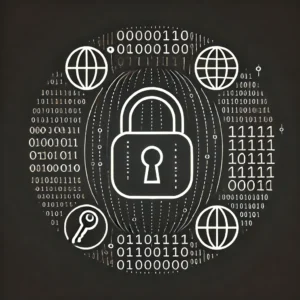Introduction to RSA
RSA (Rivest-Shamir-Adleman) is one of the first public-key cryptosystems and is widely used for secure data transmission. Invented in 1977 by Ron Rivest, Adi Shamir, and Leonard Adleman, RSA encryption has become a staple in secure communications. This guide will break down the technical aspects and the mathematics behind RSA in a simple and understandable way.
How RSA Works
RSA is a public-key encryption system, which means it uses two keys: a public key for encrypting messages and a private key for decrypting them. The strength of RSA lies in its use of large prime numbers and modular arithmetic, making it extremely difficult to break.
Key Generation
1. Selecting Primes and Calculating Modulus:
- Choose two large prime numbers, 𝑝p, and 𝑞q.
- Calculate the modulus 𝑛n by multiplying 𝑝p and 𝑞q. The modulus is part of the public and private keys and its length, in bits, is the key length.
2. Deriving the Encryption Key:
- Calculate 𝜙(𝑛)ϕ(n) (Euler’s totient function), which is (𝑝−1)(𝑞−1)(p−1)(q−1).
- Choose an integer 𝑒e such that 1<𝑒<𝜙(𝑛)1<e<ϕ(n) and 𝑒e is co-prime to 𝜙(𝑛)ϕ(n); 𝑒e typically is 65537 as it’s a prime number, making it computationally efficient.
3. Calculating the Decryption Key:
- Compute 𝑑d as the modular multiplicative inverse of 𝑒e modulo 𝜙(𝑛)ϕ(n). This means 𝑑d is the number that satisfies the equation 𝑒𝑑≡1(mod𝜙(𝑛))ed≡1(modϕ(n)).
The public key is made of the modulus 𝑛n and the exponent 𝑒e, while the private key consists of the modulus 𝑛n and the exponent 𝑑d.
Encryption and Decryption Process
Encryption:
- Convert the plaintext into an integer 𝑚m that is smaller than 𝑛n.
- Compute the ciphertext 𝑐c using the formula 𝑐≡𝑚𝑒(mod𝑛)c≡me(modn).
Decryption:
- Compute the plaintext 𝑚m using the private key with the formula 𝑚≡𝑐𝑑(mod𝑛)m≡cd(modn).
Mathematical Foundation
RSA’s security relies heavily on the difficulty of factoring the product of two large prime numbers. The public and private keys are linked mathematically, but discovering the private key from the public key requires one to factorize the modulus 𝑛n into its prime components—a task that becomes exceedingly difficult as the size of the primes increases.
Example of RSA Encryption and Decryption
Let’s walk through a simplified example of RSA encryption and decryption to better understand how it works in practice, including the mathematical steps involved.
Step 1: Key Generation
- Choose two prime numbers:
- Let 𝑝=61p=61 and 𝑞=53q=53.
- Compute 𝑛=𝑝×𝑞n=p×q:
- 𝑛=61×53=3233n=61×53=3233.
- Compute Euler’s totient function 𝜙(𝑛)ϕ(n):
- 𝜙(𝑛)=(𝑝−1)×(𝑞−1)=60×52=3120ϕ(n)=(p−1)×(q−1)=60×52=3120.
- Choose public key exponent 𝑒e such that 1<𝑒<𝜙(𝑛)1<e<ϕ(n) and 𝑒e and 𝜙(𝑛)ϕ(n) are coprime:
- Let 𝑒=17e=17 (It is a common choice and coprime to 3120).
- Calculate the private key exponent 𝑑d which is the modular multiplicative inverse of 𝑒e modulo 𝜙(𝑛)ϕ(n):
- 𝑑d must satisfy 𝑒×𝑑≡1mod 𝜙(𝑛)e×d≡1modϕ(n).
- Using the extended Euclidean algorithm, 𝑑=2753d=2753.
Public key: (𝑛,𝑒)=(3233,17)(n,e)=(3233,17)
Private key: (𝑛,𝑑)=(3233,2753)(n,d)=(3233,2753)
Step 2: Encryption
Suppose Alice wants to send the plaintext message 𝑚=123m=123 to Bob.
- Encrypt using Bob’s public key:
- 𝑐=𝑚𝑒mod 𝑛c=memodn
- 𝑐=12317mod 3233c=12317mod3233
- 𝑐=855c=855 (This is the ciphertext).
Step 3: Decryption
Bob receives 𝑐=855c=855 and uses his private key to decrypt the message.
- Decrypt using private key:
- 𝑚=𝑐𝑑mod 𝑛m=cdmodn
- 𝑚=8552753mod 3233m=8552753mod3233
- 𝑚=123m=123 (Bob successfully retrieves the original plaintext).
Practical Security Considerations
Key Size:
- The strength of RSA encryption directly correlates with the key size. Commonly, keys are at least 2048 bits long.
Key Storage and Management:
- Safely storing and managing the private key is crucial, as anyone with access to it can decrypt the data.
RSA’s Role in Modern Cryptography
RSA is foundational in many secure protocols like SSL/TLS which secure communications on the Internet. It’s also used in digital signatures, another critical aspect of modern cybersecurity.
Limitations and Future
While RSA is secure when correctly implemented with sufficiently large keys, it is not as efficient as some newer algorithms and is vulnerable to quantum attacks. The cryptographic community is actively researching post-quantum cryptography to find secure alternatives to RSA that can resist quantum computer attacks.
Conclusion
RSA encryption is a powerful tool in the cryptographic arsenal, providing security for everything from online transactions to sensitive communication. Understanding its underlying principles and correct implementation is essential for maintaining the confidentiality and integrity of data in a digitally connected world. For those interested in diving deeper into RSA’s mathematical intricacies or its implementation challenges, resources and advanced texts on cryptography are recommended.






